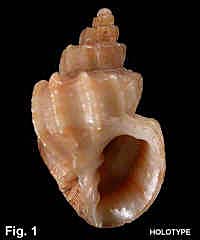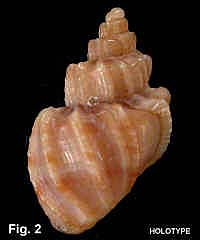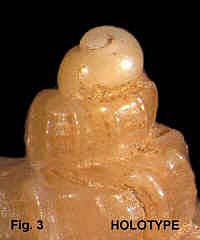|
|
|
|
|
Scalptia vinnulum (Iredale, 1925) Description: Protoconch 1½ to 1¾ whorls, asymmetrical, first half whorl greatly submerged. Teleoconch whorls sharply shouldered, sutural ramp crossed obliquely by axial ribs, edged by weak rib on shoulder. Axial sculpture of strong ribs, about eight on body whorl, thickened or with rounded, lamellose nodules at shoulder. Spiral sculpture of fine threads. Umbilicus moderately wide; columella with three strong plaits; inner lip reflected partly over umbilicus. Outer lip with about 11 lirae internally; posterior of aperture with one lira internally. Colour fawn with bands of brown and white. Size: Up to 16 mm in length. Distribution: Endemic to Australia: Tweed Heads, NSW, southwards to Twofold Bay, NSW. Habitat: Known from 9-91 m, and rarely as beach shells. Uncommon. Comparison: This species is readily distinguished from the Indo-West Pacific species of Scalptia by its paucispiral protoconch (Fig. 3) - only 1½ to 1¾ whorls, very asymmetrical, with the first half whorl greatly submerged - and by the moderately wide umbilicus.
Synonymy: Trigonaphera interlaevis Laseron, 1955 falls within the range of variation of this species (NEW SYNONYM). It is not Scalptia bicolor (Hinds, 1843), as stated by Garrard (1975); Laseron gave a good illustration of the protoconch in the original description, showing it to be quite different to S. bicolor. Remarks: This is the only species of Scalptia to occur at all frequently in NSW. Garrard (1975) reported Scalptia bicolor (Hinds, 1843) from NSW, quoting a record of 70-80 m off Cronulla; examination of his specimen shows it is S. vinnulum. He also regarded Trigonaphera interlaevis Laseron, 1955, the type of which is from Port Stevens, as S. bicolor, but that species is also the same as S. vinnulum. Three other tropical Indo-West Pacific species of Scalptia have been recorded very rarely from NSW, as given in the "Coverage" section of the introduction to this family. Fig. 1,2,3 HOLOTYPE Twofold Bay, NSW (C.053774) |


